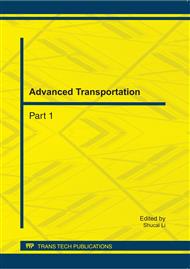p.3
p.10
p.17
p.23
p.28
p.32
p.36
p.40
The Calculation of the Supporting Stress of Track Plate in Ballastless High-Speed Rail Structure
Abstract:
The slab track is a new sort of track structure, which has been widely used in high-speed rail and special line for passenger. However, the ballastless track structure design theory is still not perfect and can not meet the requirements of current high-speed rail and passenger line ballastless track. In this paper, composite beam method is used to calculate the deflection of the track plate and in this way the vertical supporting stress distribution of the track plate can be gotten which set a basis for the follow-up study of the dynamic stress distribution in the subgrade. Slab track plate’s bearing stress under moving load is analyzed through Matlab program. By calculation and analysis, it is found that the deflection of track plate and the rail in the double-point-supported finite beam model refers to the rate of spring coefficient of the fastener and the mortar.The supporting stress of the rail plate is inversely proportional to the supporting stress of the rail. The two boundary conditions of that model ,namely, setting the end of the model in the seams of the track plate or not , have little effect on the results. We can use the supporting stress of the track plates on state 1to get the distribution of the supporting stress in the track plate when bogies pass. Also, when the dynamic load magnification factor is 1.2, the track plate supporting stress of CRST I & CRST II-plate non-ballasted structure is around 40kPa.
Info:
Periodical:
Pages:
3-9
Citation:
Online since:
September 2011
Authors:
Keywords:
Price:
Сopyright:
© 2011 Trans Tech Publications Ltd. All Rights Reserved
Share:
Citation:


